Decision Making on Mega Project: Infrastructure and Economic Impact
VerifiedAdded on 2020/05/16
|6
|1938
|308
Report
AI Summary
This report delves into the crucial aspects of decision-making within mega projects, particularly focusing on the pivotal role of infrastructure in shaping business landscapes and driving economic growth, with a specific lens on the Australian context. The analysis encompasses the transformative impact of urbanization, population growth, and technological advancements on infrastructure development, highlighting the symbiotic relationship between infrastructure and economic progress. It explores the challenges and opportunities associated with infrastructure planning, emphasizing the need for strategic policy reforms, addressing congestion issues in cities like Sydney, and adapting to environmental concerns. The report underscores the significance of efficient infrastructure to attract foreign investment, facilitate innovation, and foster a dynamic workforce, while also acknowledging the hurdles such as lack of adequate support, growing population, and climate change. The study provides insights into the current state of infrastructure, identifies key challenges, and proposes recommendations for future development, ultimately advocating for government-led initiatives to create an environment conducive to infrastructure investment and innovation.
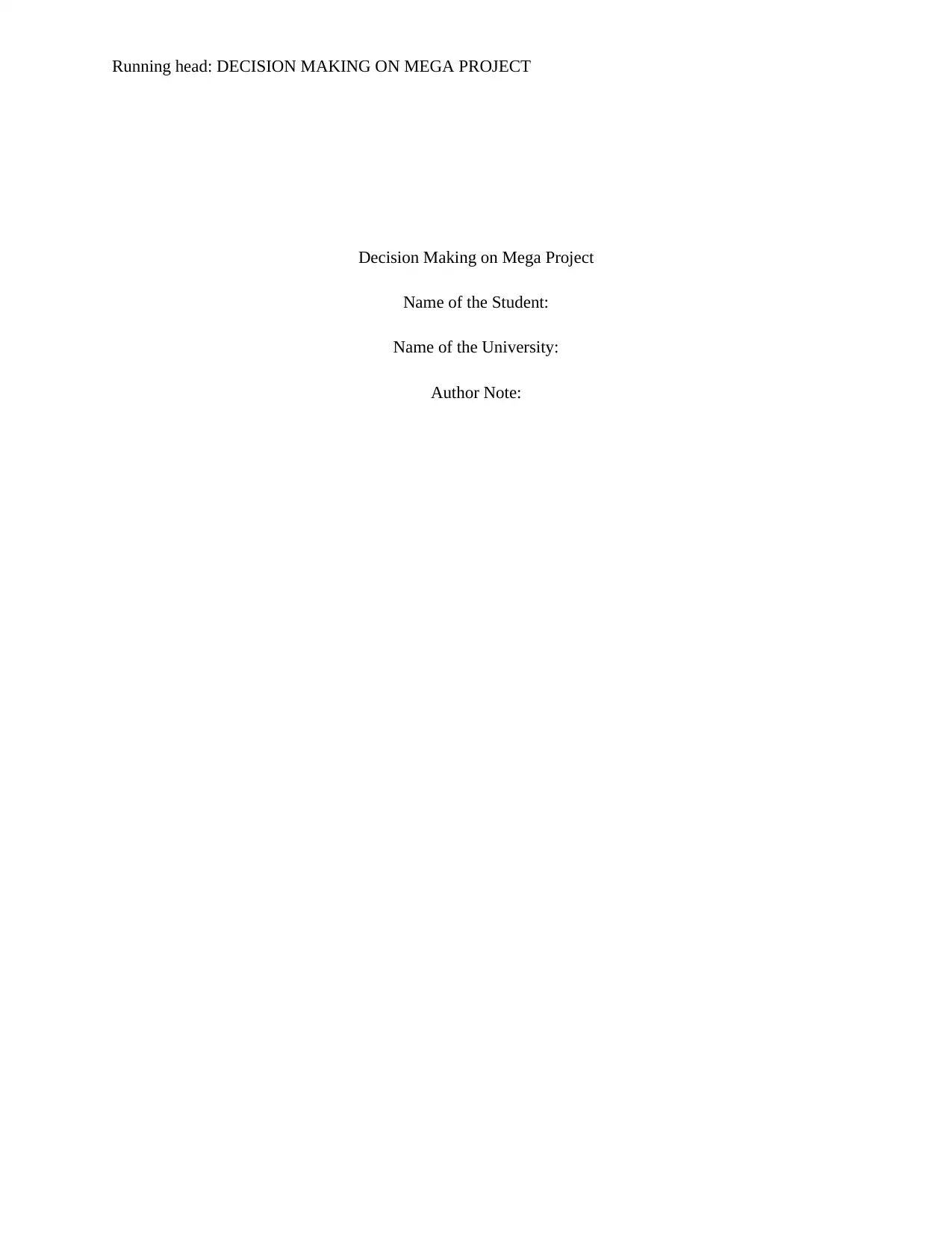
Running head: DECISION MAKING ON MEGA PROJECT
Decision Making on Mega Project
Name of the Student:
Name of the University:
Author Note:
Decision Making on Mega Project
Name of the Student:
Name of the University:
Author Note:
Paraphrase This Document
Need a fresh take? Get an instant paraphrase of this document with our AI Paraphraser
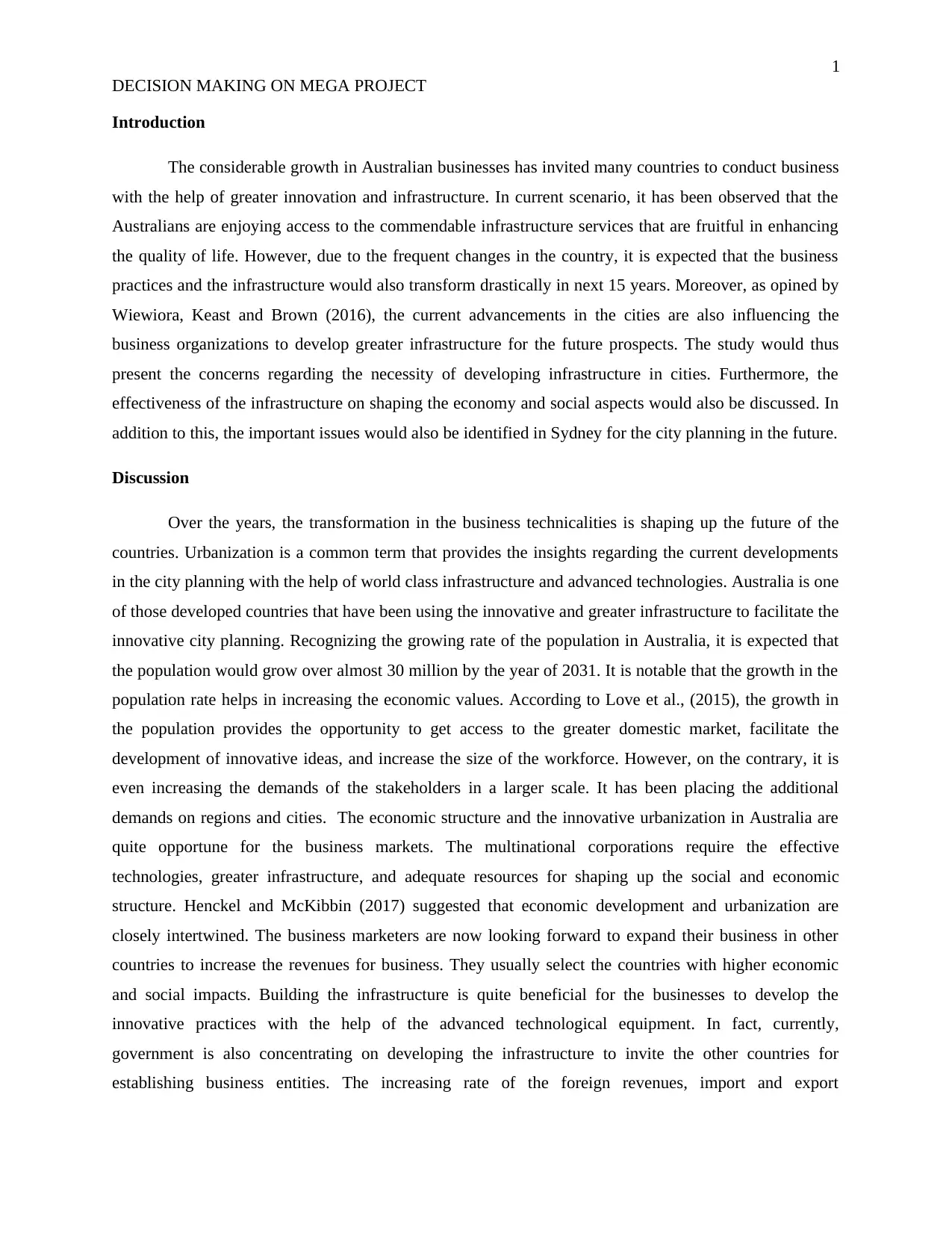
1
DECISION MAKING ON MEGA PROJECT
Introduction
The considerable growth in Australian businesses has invited many countries to conduct business
with the help of greater innovation and infrastructure. In current scenario, it has been observed that the
Australians are enjoying access to the commendable infrastructure services that are fruitful in enhancing
the quality of life. However, due to the frequent changes in the country, it is expected that the business
practices and the infrastructure would also transform drastically in next 15 years. Moreover, as opined by
Wiewiora, Keast and Brown (2016), the current advancements in the cities are also influencing the
business organizations to develop greater infrastructure for the future prospects. The study would thus
present the concerns regarding the necessity of developing infrastructure in cities. Furthermore, the
effectiveness of the infrastructure on shaping the economy and social aspects would also be discussed. In
addition to this, the important issues would also be identified in Sydney for the city planning in the future.
Discussion
Over the years, the transformation in the business technicalities is shaping up the future of the
countries. Urbanization is a common term that provides the insights regarding the current developments
in the city planning with the help of world class infrastructure and advanced technologies. Australia is one
of those developed countries that have been using the innovative and greater infrastructure to facilitate the
innovative city planning. Recognizing the growing rate of the population in Australia, it is expected that
the population would grow over almost 30 million by the year of 2031. It is notable that the growth in the
population rate helps in increasing the economic values. According to Love et al., (2015), the growth in
the population provides the opportunity to get access to the greater domestic market, facilitate the
development of innovative ideas, and increase the size of the workforce. However, on the contrary, it is
even increasing the demands of the stakeholders in a larger scale. It has been placing the additional
demands on regions and cities. The economic structure and the innovative urbanization in Australia are
quite opportune for the business markets. The multinational corporations require the effective
technologies, greater infrastructure, and adequate resources for shaping up the social and economic
structure. Henckel and McKibbin (2017) suggested that economic development and urbanization are
closely intertwined. The business marketers are now looking forward to expand their business in other
countries to increase the revenues for business. They usually select the countries with higher economic
and social impacts. Building the infrastructure is quite beneficial for the businesses to develop the
innovative practices with the help of the advanced technological equipment. In fact, currently,
government is also concentrating on developing the infrastructure to invite the other countries for
establishing business entities. The increasing rate of the foreign revenues, import and export
DECISION MAKING ON MEGA PROJECT
Introduction
The considerable growth in Australian businesses has invited many countries to conduct business
with the help of greater innovation and infrastructure. In current scenario, it has been observed that the
Australians are enjoying access to the commendable infrastructure services that are fruitful in enhancing
the quality of life. However, due to the frequent changes in the country, it is expected that the business
practices and the infrastructure would also transform drastically in next 15 years. Moreover, as opined by
Wiewiora, Keast and Brown (2016), the current advancements in the cities are also influencing the
business organizations to develop greater infrastructure for the future prospects. The study would thus
present the concerns regarding the necessity of developing infrastructure in cities. Furthermore, the
effectiveness of the infrastructure on shaping the economy and social aspects would also be discussed. In
addition to this, the important issues would also be identified in Sydney for the city planning in the future.
Discussion
Over the years, the transformation in the business technicalities is shaping up the future of the
countries. Urbanization is a common term that provides the insights regarding the current developments
in the city planning with the help of world class infrastructure and advanced technologies. Australia is one
of those developed countries that have been using the innovative and greater infrastructure to facilitate the
innovative city planning. Recognizing the growing rate of the population in Australia, it is expected that
the population would grow over almost 30 million by the year of 2031. It is notable that the growth in the
population rate helps in increasing the economic values. According to Love et al., (2015), the growth in
the population provides the opportunity to get access to the greater domestic market, facilitate the
development of innovative ideas, and increase the size of the workforce. However, on the contrary, it is
even increasing the demands of the stakeholders in a larger scale. It has been placing the additional
demands on regions and cities. The economic structure and the innovative urbanization in Australia are
quite opportune for the business markets. The multinational corporations require the effective
technologies, greater infrastructure, and adequate resources for shaping up the social and economic
structure. Henckel and McKibbin (2017) suggested that economic development and urbanization are
closely intertwined. The business marketers are now looking forward to expand their business in other
countries to increase the revenues for business. They usually select the countries with higher economic
and social impacts. Building the infrastructure is quite beneficial for the businesses to develop the
innovative practices with the help of the advanced technological equipment. In fact, currently,
government is also concentrating on developing the infrastructure to invite the other countries for
establishing business entities. The increasing rate of the foreign revenues, import and export
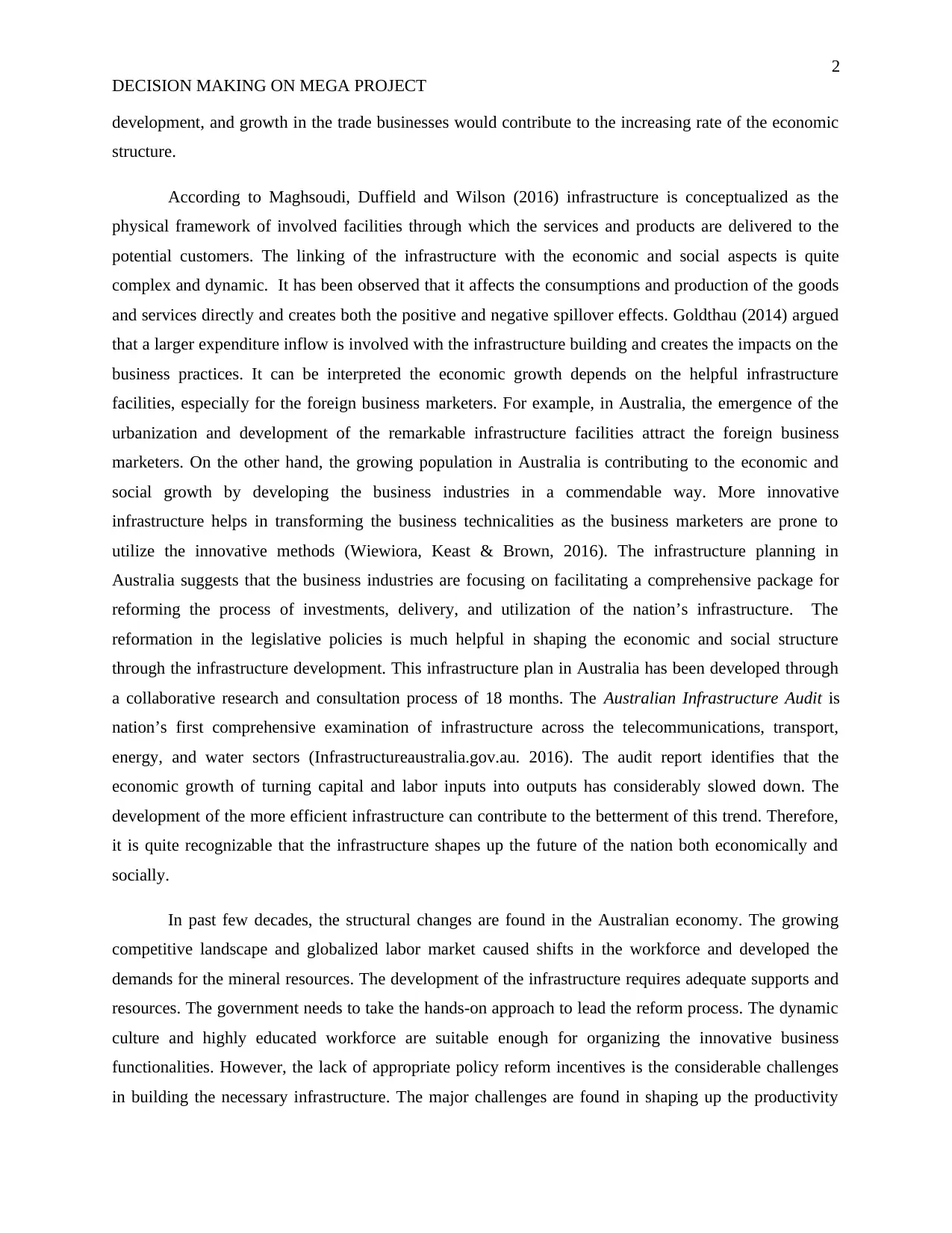
2
DECISION MAKING ON MEGA PROJECT
development, and growth in the trade businesses would contribute to the increasing rate of the economic
structure.
According to Maghsoudi, Duffield and Wilson (2016) infrastructure is conceptualized as the
physical framework of involved facilities through which the services and products are delivered to the
potential customers. The linking of the infrastructure with the economic and social aspects is quite
complex and dynamic. It has been observed that it affects the consumptions and production of the goods
and services directly and creates both the positive and negative spillover effects. Goldthau (2014) argued
that a larger expenditure inflow is involved with the infrastructure building and creates the impacts on the
business practices. It can be interpreted the economic growth depends on the helpful infrastructure
facilities, especially for the foreign business marketers. For example, in Australia, the emergence of the
urbanization and development of the remarkable infrastructure facilities attract the foreign business
marketers. On the other hand, the growing population in Australia is contributing to the economic and
social growth by developing the business industries in a commendable way. More innovative
infrastructure helps in transforming the business technicalities as the business marketers are prone to
utilize the innovative methods (Wiewiora, Keast & Brown, 2016). The infrastructure planning in
Australia suggests that the business industries are focusing on facilitating a comprehensive package for
reforming the process of investments, delivery, and utilization of the nation’s infrastructure. The
reformation in the legislative policies is much helpful in shaping the economic and social structure
through the infrastructure development. This infrastructure plan in Australia has been developed through
a collaborative research and consultation process of 18 months. The Australian Infrastructure Audit is
nation’s first comprehensive examination of infrastructure across the telecommunications, transport,
energy, and water sectors (Infrastructureaustralia.gov.au. 2016). The audit report identifies that the
economic growth of turning capital and labor inputs into outputs has considerably slowed down. The
development of the more efficient infrastructure can contribute to the betterment of this trend. Therefore,
it is quite recognizable that the infrastructure shapes up the future of the nation both economically and
socially.
In past few decades, the structural changes are found in the Australian economy. The growing
competitive landscape and globalized labor market caused shifts in the workforce and developed the
demands for the mineral resources. The development of the infrastructure requires adequate supports and
resources. The government needs to take the hands-on approach to lead the reform process. The dynamic
culture and highly educated workforce are suitable enough for organizing the innovative business
functionalities. However, the lack of appropriate policy reform incentives is the considerable challenges
in building the necessary infrastructure. The major challenges are found in shaping up the productivity
DECISION MAKING ON MEGA PROJECT
development, and growth in the trade businesses would contribute to the increasing rate of the economic
structure.
According to Maghsoudi, Duffield and Wilson (2016) infrastructure is conceptualized as the
physical framework of involved facilities through which the services and products are delivered to the
potential customers. The linking of the infrastructure with the economic and social aspects is quite
complex and dynamic. It has been observed that it affects the consumptions and production of the goods
and services directly and creates both the positive and negative spillover effects. Goldthau (2014) argued
that a larger expenditure inflow is involved with the infrastructure building and creates the impacts on the
business practices. It can be interpreted the economic growth depends on the helpful infrastructure
facilities, especially for the foreign business marketers. For example, in Australia, the emergence of the
urbanization and development of the remarkable infrastructure facilities attract the foreign business
marketers. On the other hand, the growing population in Australia is contributing to the economic and
social growth by developing the business industries in a commendable way. More innovative
infrastructure helps in transforming the business technicalities as the business marketers are prone to
utilize the innovative methods (Wiewiora, Keast & Brown, 2016). The infrastructure planning in
Australia suggests that the business industries are focusing on facilitating a comprehensive package for
reforming the process of investments, delivery, and utilization of the nation’s infrastructure. The
reformation in the legislative policies is much helpful in shaping the economic and social structure
through the infrastructure development. This infrastructure plan in Australia has been developed through
a collaborative research and consultation process of 18 months. The Australian Infrastructure Audit is
nation’s first comprehensive examination of infrastructure across the telecommunications, transport,
energy, and water sectors (Infrastructureaustralia.gov.au. 2016). The audit report identifies that the
economic growth of turning capital and labor inputs into outputs has considerably slowed down. The
development of the more efficient infrastructure can contribute to the betterment of this trend. Therefore,
it is quite recognizable that the infrastructure shapes up the future of the nation both economically and
socially.
In past few decades, the structural changes are found in the Australian economy. The growing
competitive landscape and globalized labor market caused shifts in the workforce and developed the
demands for the mineral resources. The development of the infrastructure requires adequate supports and
resources. The government needs to take the hands-on approach to lead the reform process. The dynamic
culture and highly educated workforce are suitable enough for organizing the innovative business
functionalities. However, the lack of appropriate policy reform incentives is the considerable challenges
in building the necessary infrastructure. The major challenges are found in shaping up the productivity
⊘ This is a preview!⊘
Do you want full access?
Subscribe today to unlock all pages.

Trusted by 1+ million students worldwide
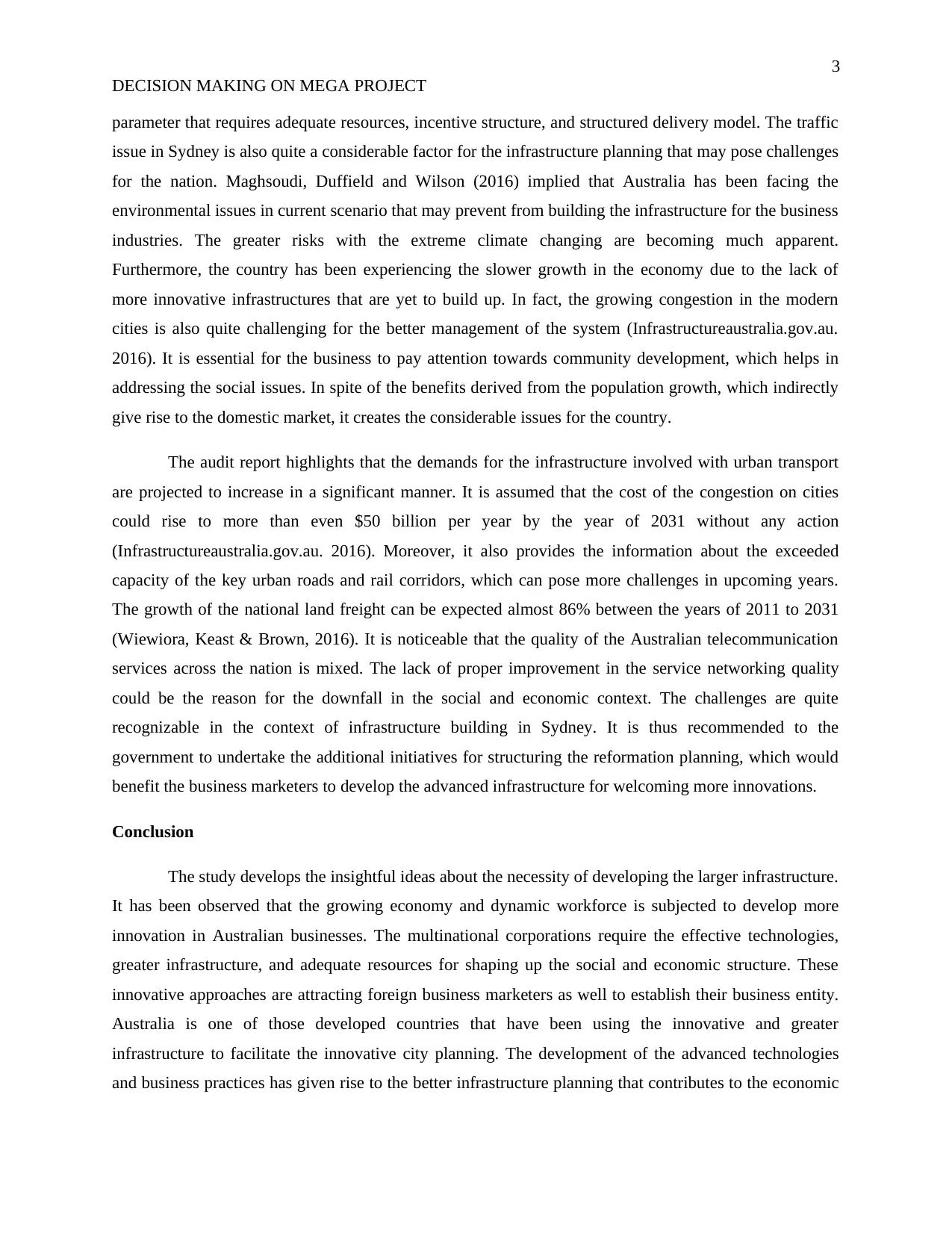
3
DECISION MAKING ON MEGA PROJECT
parameter that requires adequate resources, incentive structure, and structured delivery model. The traffic
issue in Sydney is also quite a considerable factor for the infrastructure planning that may pose challenges
for the nation. Maghsoudi, Duffield and Wilson (2016) implied that Australia has been facing the
environmental issues in current scenario that may prevent from building the infrastructure for the business
industries. The greater risks with the extreme climate changing are becoming much apparent.
Furthermore, the country has been experiencing the slower growth in the economy due to the lack of
more innovative infrastructures that are yet to build up. In fact, the growing congestion in the modern
cities is also quite challenging for the better management of the system (Infrastructureaustralia.gov.au.
2016). It is essential for the business to pay attention towards community development, which helps in
addressing the social issues. In spite of the benefits derived from the population growth, which indirectly
give rise to the domestic market, it creates the considerable issues for the country.
The audit report highlights that the demands for the infrastructure involved with urban transport
are projected to increase in a significant manner. It is assumed that the cost of the congestion on cities
could rise to more than even $50 billion per year by the year of 2031 without any action
(Infrastructureaustralia.gov.au. 2016). Moreover, it also provides the information about the exceeded
capacity of the key urban roads and rail corridors, which can pose more challenges in upcoming years.
The growth of the national land freight can be expected almost 86% between the years of 2011 to 2031
(Wiewiora, Keast & Brown, 2016). It is noticeable that the quality of the Australian telecommunication
services across the nation is mixed. The lack of proper improvement in the service networking quality
could be the reason for the downfall in the social and economic context. The challenges are quite
recognizable in the context of infrastructure building in Sydney. It is thus recommended to the
government to undertake the additional initiatives for structuring the reformation planning, which would
benefit the business marketers to develop the advanced infrastructure for welcoming more innovations.
Conclusion
The study develops the insightful ideas about the necessity of developing the larger infrastructure.
It has been observed that the growing economy and dynamic workforce is subjected to develop more
innovation in Australian businesses. The multinational corporations require the effective technologies,
greater infrastructure, and adequate resources for shaping up the social and economic structure. These
innovative approaches are attracting foreign business marketers as well to establish their business entity.
Australia is one of those developed countries that have been using the innovative and greater
infrastructure to facilitate the innovative city planning. The development of the advanced technologies
and business practices has given rise to the better infrastructure planning that contributes to the economic
DECISION MAKING ON MEGA PROJECT
parameter that requires adequate resources, incentive structure, and structured delivery model. The traffic
issue in Sydney is also quite a considerable factor for the infrastructure planning that may pose challenges
for the nation. Maghsoudi, Duffield and Wilson (2016) implied that Australia has been facing the
environmental issues in current scenario that may prevent from building the infrastructure for the business
industries. The greater risks with the extreme climate changing are becoming much apparent.
Furthermore, the country has been experiencing the slower growth in the economy due to the lack of
more innovative infrastructures that are yet to build up. In fact, the growing congestion in the modern
cities is also quite challenging for the better management of the system (Infrastructureaustralia.gov.au.
2016). It is essential for the business to pay attention towards community development, which helps in
addressing the social issues. In spite of the benefits derived from the population growth, which indirectly
give rise to the domestic market, it creates the considerable issues for the country.
The audit report highlights that the demands for the infrastructure involved with urban transport
are projected to increase in a significant manner. It is assumed that the cost of the congestion on cities
could rise to more than even $50 billion per year by the year of 2031 without any action
(Infrastructureaustralia.gov.au. 2016). Moreover, it also provides the information about the exceeded
capacity of the key urban roads and rail corridors, which can pose more challenges in upcoming years.
The growth of the national land freight can be expected almost 86% between the years of 2011 to 2031
(Wiewiora, Keast & Brown, 2016). It is noticeable that the quality of the Australian telecommunication
services across the nation is mixed. The lack of proper improvement in the service networking quality
could be the reason for the downfall in the social and economic context. The challenges are quite
recognizable in the context of infrastructure building in Sydney. It is thus recommended to the
government to undertake the additional initiatives for structuring the reformation planning, which would
benefit the business marketers to develop the advanced infrastructure for welcoming more innovations.
Conclusion
The study develops the insightful ideas about the necessity of developing the larger infrastructure.
It has been observed that the growing economy and dynamic workforce is subjected to develop more
innovation in Australian businesses. The multinational corporations require the effective technologies,
greater infrastructure, and adequate resources for shaping up the social and economic structure. These
innovative approaches are attracting foreign business marketers as well to establish their business entity.
Australia is one of those developed countries that have been using the innovative and greater
infrastructure to facilitate the innovative city planning. The development of the advanced technologies
and business practices has given rise to the better infrastructure planning that contributes to the economic
Paraphrase This Document
Need a fresh take? Get an instant paraphrase of this document with our AI Paraphraser
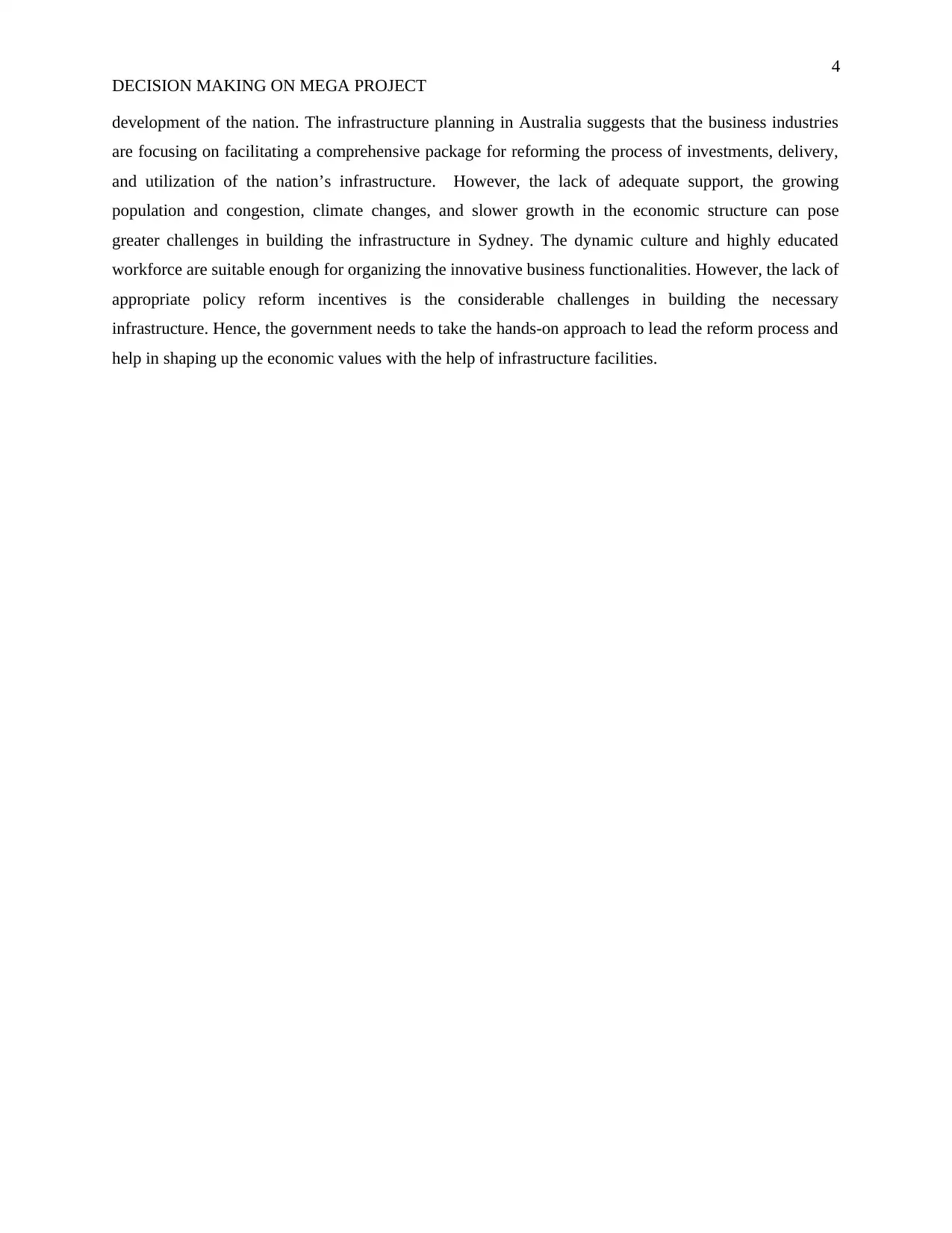
4
DECISION MAKING ON MEGA PROJECT
development of the nation. The infrastructure planning in Australia suggests that the business industries
are focusing on facilitating a comprehensive package for reforming the process of investments, delivery,
and utilization of the nation’s infrastructure. However, the lack of adequate support, the growing
population and congestion, climate changes, and slower growth in the economic structure can pose
greater challenges in building the infrastructure in Sydney. The dynamic culture and highly educated
workforce are suitable enough for organizing the innovative business functionalities. However, the lack of
appropriate policy reform incentives is the considerable challenges in building the necessary
infrastructure. Hence, the government needs to take the hands-on approach to lead the reform process and
help in shaping up the economic values with the help of infrastructure facilities.
DECISION MAKING ON MEGA PROJECT
development of the nation. The infrastructure planning in Australia suggests that the business industries
are focusing on facilitating a comprehensive package for reforming the process of investments, delivery,
and utilization of the nation’s infrastructure. However, the lack of adequate support, the growing
population and congestion, climate changes, and slower growth in the economic structure can pose
greater challenges in building the infrastructure in Sydney. The dynamic culture and highly educated
workforce are suitable enough for organizing the innovative business functionalities. However, the lack of
appropriate policy reform incentives is the considerable challenges in building the necessary
infrastructure. Hence, the government needs to take the hands-on approach to lead the reform process and
help in shaping up the economic values with the help of infrastructure facilities.
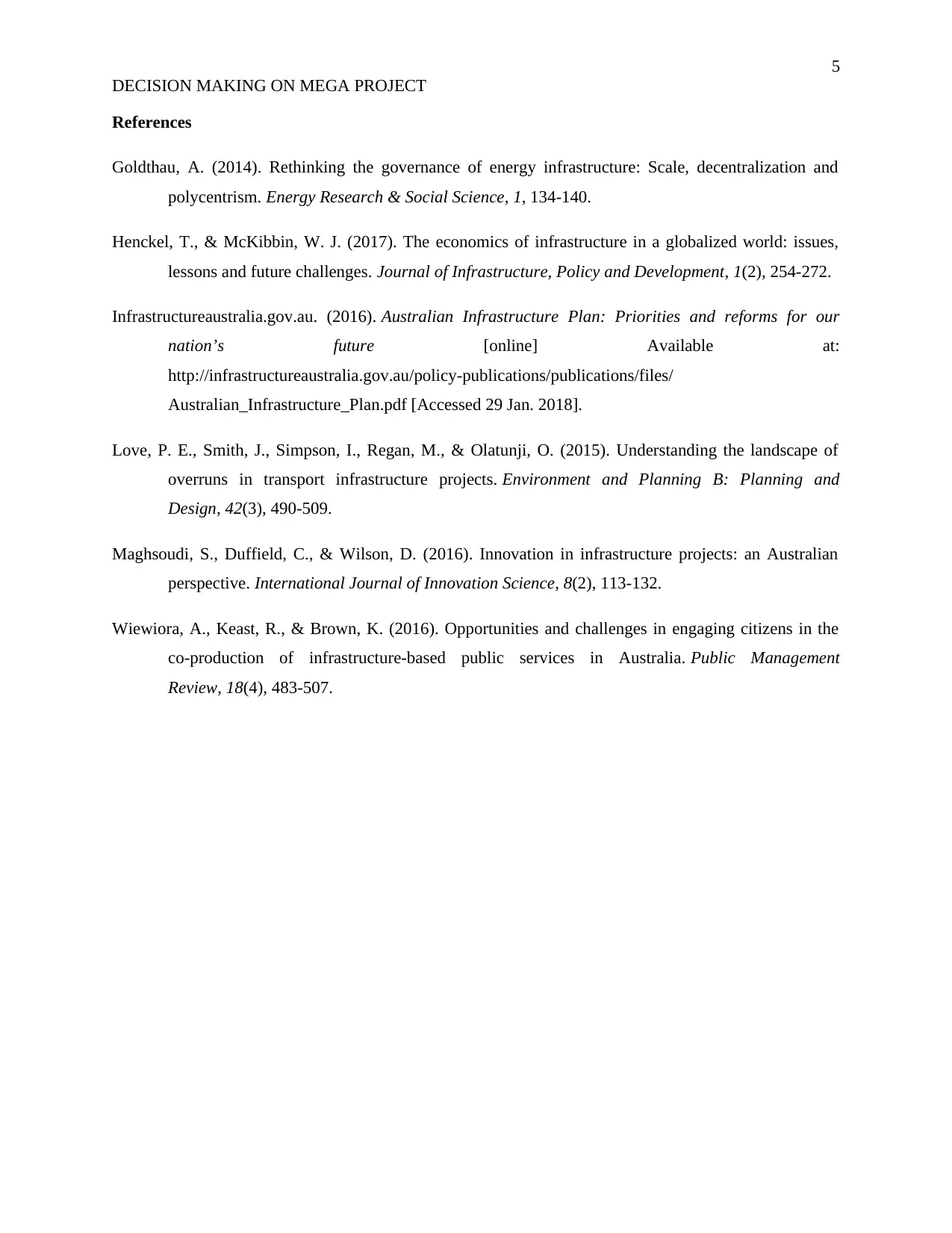
5
DECISION MAKING ON MEGA PROJECT
References
Goldthau, A. (2014). Rethinking the governance of energy infrastructure: Scale, decentralization and
polycentrism. Energy Research & Social Science, 1, 134-140.
Henckel, T., & McKibbin, W. J. (2017). The economics of infrastructure in a globalized world: issues,
lessons and future challenges. Journal of Infrastructure, Policy and Development, 1(2), 254-272.
Infrastructureaustralia.gov.au. (2016). Australian Infrastructure Plan: Priorities and reforms for our
nation’s future [online] Available at:
http://infrastructureaustralia.gov.au/policy-publications/publications/files/
Australian_Infrastructure_Plan.pdf [Accessed 29 Jan. 2018].
Love, P. E., Smith, J., Simpson, I., Regan, M., & Olatunji, O. (2015). Understanding the landscape of
overruns in transport infrastructure projects. Environment and Planning B: Planning and
Design, 42(3), 490-509.
Maghsoudi, S., Duffield, C., & Wilson, D. (2016). Innovation in infrastructure projects: an Australian
perspective. International Journal of Innovation Science, 8(2), 113-132.
Wiewiora, A., Keast, R., & Brown, K. (2016). Opportunities and challenges in engaging citizens in the
co-production of infrastructure-based public services in Australia. Public Management
Review, 18(4), 483-507.
DECISION MAKING ON MEGA PROJECT
References
Goldthau, A. (2014). Rethinking the governance of energy infrastructure: Scale, decentralization and
polycentrism. Energy Research & Social Science, 1, 134-140.
Henckel, T., & McKibbin, W. J. (2017). The economics of infrastructure in a globalized world: issues,
lessons and future challenges. Journal of Infrastructure, Policy and Development, 1(2), 254-272.
Infrastructureaustralia.gov.au. (2016). Australian Infrastructure Plan: Priorities and reforms for our
nation’s future [online] Available at:
http://infrastructureaustralia.gov.au/policy-publications/publications/files/
Australian_Infrastructure_Plan.pdf [Accessed 29 Jan. 2018].
Love, P. E., Smith, J., Simpson, I., Regan, M., & Olatunji, O. (2015). Understanding the landscape of
overruns in transport infrastructure projects. Environment and Planning B: Planning and
Design, 42(3), 490-509.
Maghsoudi, S., Duffield, C., & Wilson, D. (2016). Innovation in infrastructure projects: an Australian
perspective. International Journal of Innovation Science, 8(2), 113-132.
Wiewiora, A., Keast, R., & Brown, K. (2016). Opportunities and challenges in engaging citizens in the
co-production of infrastructure-based public services in Australia. Public Management
Review, 18(4), 483-507.
⊘ This is a preview!⊘
Do you want full access?
Subscribe today to unlock all pages.

Trusted by 1+ million students worldwide
1 out of 6
Related Documents
Your All-in-One AI-Powered Toolkit for Academic Success.
+13062052269
info@desklib.com
Available 24*7 on WhatsApp / Email
![[object Object]](/_next/static/media/star-bottom.7253800d.svg)
Unlock your academic potential
Copyright © 2020–2025 A2Z Services. All Rights Reserved. Developed and managed by ZUCOL.





